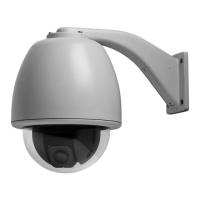UltraView PTZ
User Manual
36
Exposure control
Exposure control for a UltraView PTZ is controlled through five different menus that affect the image
exposure.
Automatic slow shutter. This feature only works when the camera is in day (color) mode. It extends the
useful range of the color mode in dark situations and keeps the camera in color mode longer before having
to switch to night mode.
Motion can become blurry when the shutter is set to autoslow. If manual shutter speed or iris is set, those
settings will override the autoslow shutter setting.
Day/night switch. This switch controls when the camera switches to day or night mode (night mode
displays black-and-white images with improved contrast and sacrificed clarity).
Autoslow shutter can be set to delay the switch to night mode until the lighting levels are very low. The
Camera Sensor takes the Autoslow shutter setting into account when it switches to night mode. The Dome
Sensor, however, does not, and must be manually adjusted towards the dark end of the settings to make the
Autoslow shutter viable.
Exposure control (iris control). Auto mode enables Backlight compensation and disables manual
control. Manual and Manual return to auto allow manual iris adjustments (or require them in Manual
only), but can vary between different camera modules.
27X and 37X cameras: The camera is put into Aperture priority mode. Aperture priority means that the iris
size remains constant at the set value, while the camera adjusts the shutter speed to compensate. When
making initial adjustments, observe the effects of the shutter speed. The image will get much brighter or
darker on subsequent adjustments, as the shutter speed becomes maxed.
The Backlight compensation feature tells the camera to adjust its total exposure (iris and shutter) to ignore
the brightest areas of the image, and instead concentrate on darker areas. Backlight compensation doesn't
have a separate menu, but is enabled by setting the iris (exposure control) to Auto.
One practical application of Backlight compensation enables you to see detail inside a room with a window
on a bright day. The autoexposure will average all the light in the scene, so bright areas, such as windows,
get greater weight, and the camera will adjust so you can see the bright area (outside). Backlight correction
forces the camera to ignore areas of high brightness, so the rest of the scene (the inside of the building) will
be properly exposed. You can see detail inside, but in the process the lighting at the window will be
adjusted so seeing outside is not possible.
Shutter speed. This menu enables the option of using iris- to manually set the shutter speed of the
camera, much in the way the iris is manually set above. For all day/night camera types, the camera is put in
Shutter priority mode.
The shutter speed is fixed, and the Iris will automatically adjust to compensate.
Setting the shutter speed is always done with the Manual/return to auto menu option, where the shutter
speed will remain fixed only as long as the camera is stationary. As soon as pan or tilt movements are
made, the shutter speed returns to Auto.
Wide dynamic range. Wide dynamic range, which is a feature of the 27X and 37X cameras, overrides all
image exposure settings except day/night switch). When Wide dynamic range is on, you should set
exposure (iris) and shutter speed to automatic. Also, Backlight compensation should not be used in wide
dynamic range mode; the feature allows you to see both dimly and brightly lit environments at the same
time.

